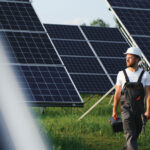
Meeting Ireland’s 2030 solar targets
4th October 2024
300GW of offshore wind energy by 2050
4th October 2024Navigating routes to market for offshore wind in Ireland: Opportunities and challenges

As Ireland accelerates towards its renewable energy targets, offshore wind will play a crucial role in meeting both domestic energy demand and climate goals.
With the development of significant offshore wind in Ireland, developers are questioning the best route to market for these projects. Developers trying to launch projects in Ireland’s nascent offshore wind sector have looked to the government-backed scheme, the Offshore Renewable Electricity Support Scheme (ORESS), for revenue certainty. However, some offshore developers are now considering corporate power purchase agreements (CPPAs) as a viable alternative.
ORESS: Advantages and disadvantages
ORESS1, a developer-led process and the first auction in ORESS, awarded four successful projects with long-term fixed price contracts for their power in June 2023. The four successful projects (Dublin Array, Codling Wind Park, Sceirde Rocks Windfarm, and North Irish Sea Array) have also obtained a grid connection assessment and maritime area consent. Two additional projects that made unsuccessful bids into ORESS1 (Arklow Bank Wind Park and Oriel Wind Farm) have been given a window by the CRU to secure an alternative route to market while maintaining their grid connection assessments. It is expected that these projects will look to CPPAs for their route to market.
For the projects that were successful in ORESS1 and for projects looking at ORESS2.1 and beyond, ORESS provides a stable revenue stream for developers by guaranteeing a floor price for the electricity generated and thus reducing the exposure to market volatility of electricity prices. Backed by the Irish Government, this route to market is attractive to third party funders of offshore wind projects. Government support reduces risk of non-payment and makes projects immediately more bankable. However, ORESS comes with its own challenges. In particular, auctions encourage a race to the bottom for pricing.
The strike prices secured by the projects in ORESS1 (an average strike price of €86.05/MWh) were lower than initially forecasted. There is also a risk that by locking in a lower price now, these projects may be more exposed to cost inflation leading up to construction.
Between now and 2030, when ORESS1 projects are expected to reach commercial operation, key costs such as raw materials, labour, and financing may rise, which would create a mismatch between the price agreed in 2023 and the actual project expenses, potentially eroding profitability. If government auctions are to be successful, they must remain commercially viable and competitive. We only have to look across the water to see the consequences of failing to do this. The UK’s fifth contract for difference auction held in September 2023 failed to attract any bids for new offshore wind projects. Inflationary provisions in future ORESS auctions would be a welcome change for many stakeholders in the industry.
Another drawback of the upcoming ORESS2.1 auction is the inability to withdraw from ORESS2.1, identified in the draft terms and conditions for ORESS2.1. This is a different approach compared to ORESS1 and RESS (the onshore subsidy scheme in Ireland) which permitted withdrawal provided that, amongst other criteria, commercial operation is achieved by the prescribed longstop date.
“CPPAs are a strong alternative route to market for offshore wind projects.”
CPPAs: A growing route to market
CPPAs are a strong alternative route to market for offshore wind projects. Similar to ORESS, CPPAs provide long-term revenue certainty by locking in a price for electricity. However, CPPAs offer greater flexibility than government backed schemes, with corporate buyers and developers able to negotiate a bespoke contract that aligns with both parties’ financial strategies. Corporations are under increasing pressure from stakeholders to meet ambitious sustainability goals with many large corporates committing to achieve carbon neutrality. These commitments create significant additional demand for renewable energy. Offshore wind projects in Ireland will play a key role in helping corporations meet these targets, while also allowing developers to benefit from a stable, long-term revenue steam.
Perhaps the most attractive aspect of CPPAs is that they provide opportunities to overcome complex capital expenditure calculations associated with government-backed auctions. These bilateral agreements can provide for price adjustments linked to inflation (not included in ORESS). A lack of inflationary measures was a key issue in RESS1 (the first onshore auction) and resulted in a large number of projects exiting the scheme in favour of CPPAs.
CPPAs also mitigate a cashflow issue which can arise for projects awarded contracts in ORESS. Payments for ORESS are based on an ex-ante (preliminary) estimate as well as an annual benchmark price set by the CRU. The associated reconciliation process (known as the “R-Factor”) adjusts for differences between the estimated and actual electricity generated and sold which can lead to cashflow challenges (in particular where a ‘supplier-lite’ model as opposed to the more common utility offtake model is adopted). The payment process is different in a CPPA as typically the settlement under such agreements are on a monthly basis.
What is next?
The final terms and conditions for ORESS2.1 are expected to be published imminently, with the auction due to run in 2025, in which interested parties will be invited to bid for the 900MW capacity which will be available at ‘Tonn Nua’, off the coast of County Waterford.
As the industry becomes more familiar with CPPAs as a route to market for offshore wind, there will be greater opportunity for their implementation. Corporate buyers with the capacity to engage in these types of arrangements will continue to look for suitable projects that match their needs in terms of project size, stage of development, and price.
In addition to ORESS and CPPAs, green hydrogen is emerging as a promising novel offtake opportunity for offshore wind in Ireland, with green hydrogen generally being seen by some large energy users like data centres as a critical future fuel source in moving away from gas. While still in its infancy, several offshore wind-to-hydrogen projects are being explored across mainland Europe and we expect to see Ireland follow suit.
If you would like to speak about offshore wind development, CPPAs or the renewable energy landscape in Ireland more generally, please reach out to:
Seán Scally, Partner and Head of Energy
T: +353 87 3859133
E: seanscally@eversheds-sutherland.ie
or
Chelsey O’Doherty, Of Counsel, Energy
T: +353 87 4301218
E: chelseyodoherty@eversheds-sutherland.ie
